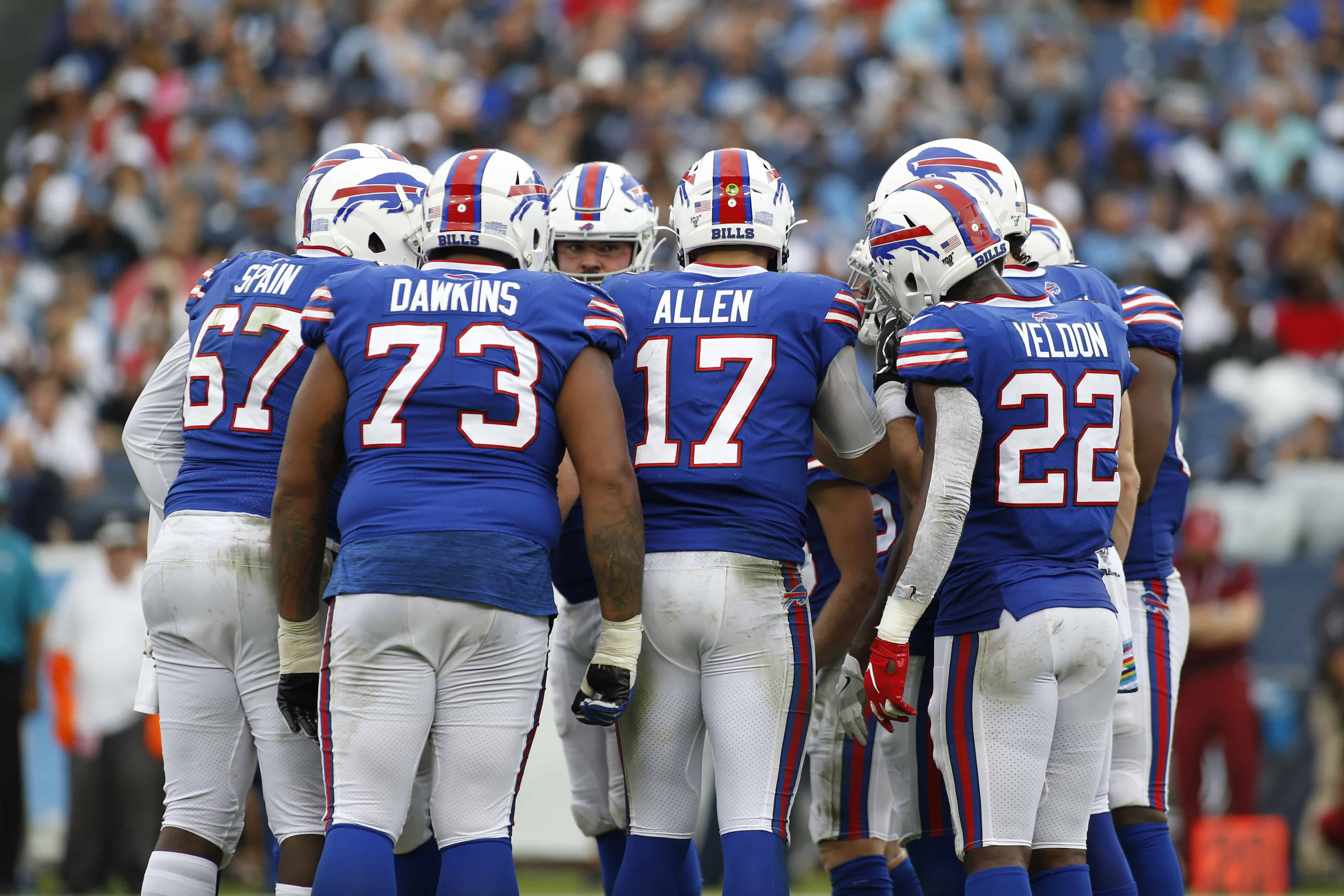Looking for detailed insights about the Buffalo Bills players, coaches, and philosophies?
This chapter from Warren Sharp’s ‘2020 Football Preview' book gets you prepared for the NFL season by delivering the smartest information & analysis in the fastest, most direct way possible.

There is something to be said for a team willing to make changes before it’s too late. Far too often we see teams continue to make the same mistakes over and over and hold off on changing because they are worried about the negatives of such changes. They pessimistically view potential negatives as a worse thing to fear than the familiar negatives.
That wasn’t the 2019 Buffalo Bills.
The 6-3 Bills were an offense that passed the ball 53% of the time on early downs in the first three quarters, identical to the league average. They used 11 personnel 59% of the time in these situations, only 4% above the league average.

Over the first 10 weeks, the Bills were dominant when running from 11 personnel on early downs. Compare their productivity by grouping:
11: 62% success, 5.7 YPC
12: 50% success, 5.1 YPC
21: 43% success, 4.7 YPC
13: 50% success, 5.3 YPC
22: 39% success, 3.1 YPC
After a Week 10 loss by three points in Cleveland, and ahead of a trip to Miami, the Bills made a few major changes. The irony of the changes was that barely anyone on a national scale even noticed.
First, offensive coordinator Brian Daboll moved from field level to the coaching booth for the first time in his career. Second, the offense dramatically increased 11 personnel. And third, they went no-huddle and hurry up a significant amount.
It’s extremely rare a team would make such a bevy of moves between two straight road games. Their bye week was Week 6. They were 6-3 on the season. But the Bills internally decided they would take the risk.
They chose to change. They decided not to fear potential negatives when they weren’t happy with familiar negatives.
So how did it go? First, we must look at the context. The Bills played the NFL’s fourth-toughest strength of schedule of defenses over the final seven weeks of the season, including the NFL’s second-toughest schedule of run defenses.
This was after playing the NFL’s fourth-easiest schedule of defenses over the first 10 weeks of the season, including the NFL’s easiest schedule of pass defenses.
As such, any statistical measure with such a wide gap in defenses isn’t going to be as useful.
For the complete Buffalo Bills chapter, including a dozen more visuals & info-graphics, Defensive breakdown and detailed Fantasy football implication — plus the other 31 team chapters — pick up a copy of Warren Sharp’s new ‘2020 Football Preview’ book and use the coupon code “BOOK10” to take $10 off at purchase.
From Week 11 on, the Bills used 11 personnel on 77% of plays on early downs in the first three quarters, the highest rate in the NFL. Wide receiver Isaiah McKenzie went from playing between 1% to 24% of snaps over the first month of the season to playing on 78% of the Bills offensive snaps down the stretch.
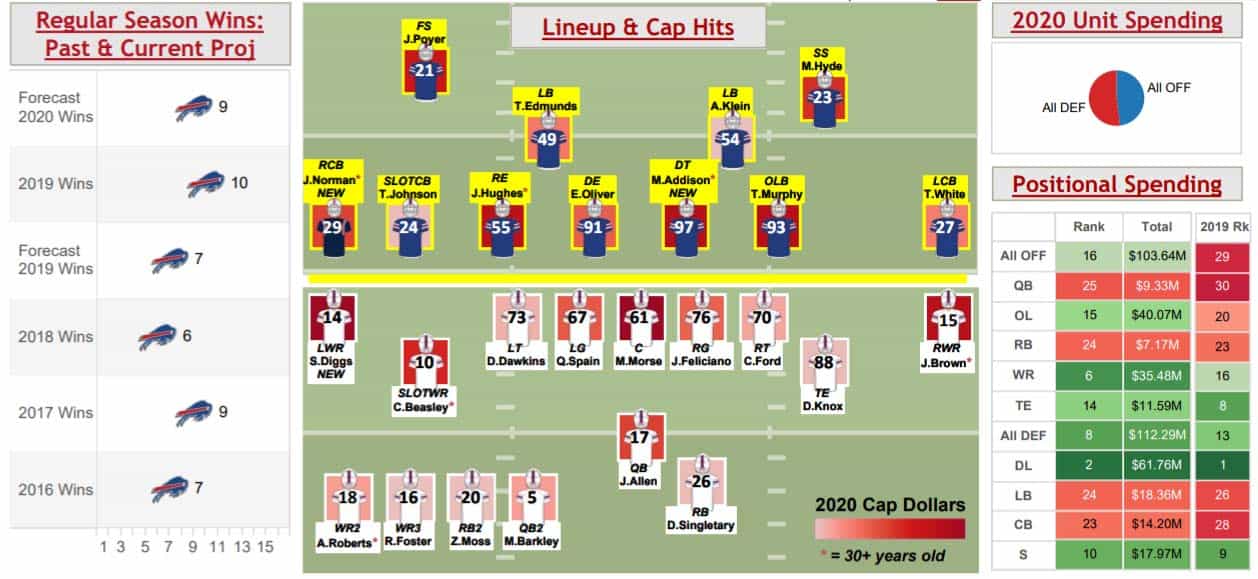
The Bills dramatically increased pace as well. In the first half of games, they went from being a below-average paced team to the fifth-fastest down the stretch. By sticking with 11 personnel, the Bills didn’t need to substitute players as often.
By getting to the line quickly, Daboll had ample time from his perch high above the field to view the defense in a way he never could from the sideline. He had enough time before radio communication cut out with quarterback Josh Allen to adjust play calls and do more to help Allen get into the right play pre-snap, as well as time to throw out anything else useful. Of course, such a pace puts the defense in a bind as they are unable to substitute players.
One result of this was more runs into lighter boxes. Likely, Daboll helped check into these runs at the line. Prior to Week 11 on early downs in the game’s first three quarters, the Bills ran the ball 37% of the time when defenses presented boxes of six or fewer defenders.
The league average was 34%. On these runs, the Bills recorded a 61% success rate and 5.6 YPC. But they still were passing the ball 63% of the time, and those passes were terrible: 6.6 YPA, 48% success, and a 1:4 TD:INT ratio.
Of Allen’s five interceptions through Week 10 on these plays, only one came on 86 attempts with box counts of 7+ men (1.2% INT rate). Meanwhile, four interceptions came on 87 attempts with box counts of six or fewer men (5.0% INT rate). With fewer defenders in the box, with much better production on the ground, and with more defenders in coverage, the Bills should have been running more — but they did not.
That changed when Daboll went upstairs. The Bills ran the ball on 53% of plays when defenses had box counts of six or fewer men, by far the highest rate in the NFL (avg 34%). It was a huge improvement.
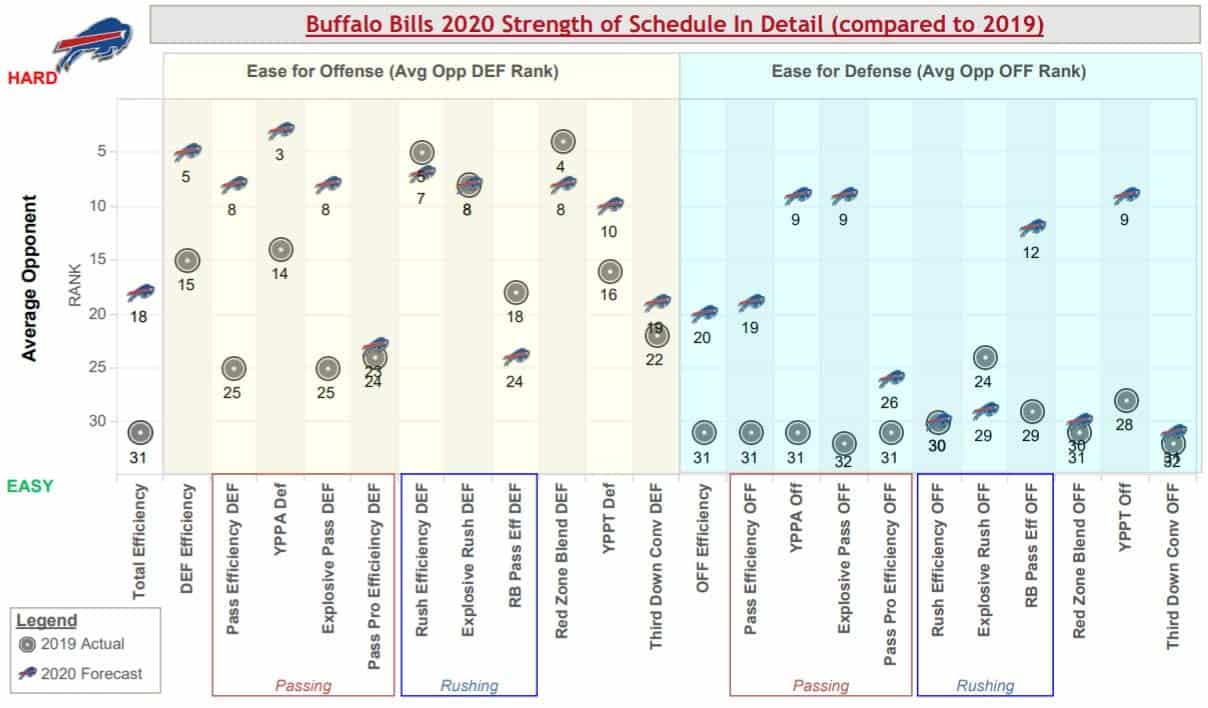
With a quarterback like Allen, it’s even more important to do everything possible to ensure you have an edge. And running on light boxes instead of throwing is definitely a key part of that.
But the Bills still weren’t perfect. Even with Daboll in the booth upstairs, Buffalo ran the ball 72% of the time against stacked boxes (8+ men) on early downs in the first three quarters. These runs generated a very poor 3.7 YPC with a 38% success rate. Yet when Josh Allen passed against these heavy boxes, he averaged 8.2 YPA, a 67% success rate, and a 116 rating.
The 72% run rate was not just in times when the offense was in a heavy set such as 13 or 22 personnel on early downs and didn’t have many options. Nearly a third of the total runs from Week 11 onward came when the team was in 11 personnel. Surprisingly, when in 11 personnel and faced with 8+ men box counts, the Bills still ran the ball on 75% of their snaps and these runs averaged 1.9 YPC and an 11% success rate. Passes produced a 100% success rate and 10.7 YPA (albeit a small sample size).
These are future areas the Bills can continue to improve, understanding this basic principle: passing wins games in the NFL and with a quarterback like Josh Allen, the Bills cannot expect him to perform like Patrick Mahomes or Deshaun Watson to make countless plays through the air while things dissolve in the pocket. The Bills must give their passing offense every edge possible if they want to receive the passing efficiency which will be required to win enough games to achieve their goals.
Other strategies the Bills can use to improve their passing efficiency include using more play-action. Buffalo was the NFL’s worst passing offense when passing without play-action in 2019 as they averaged 6.2 YPA and a 42% success rate. But when using play-action, they raised their YPA by 2.0 yards and improved their success rate by 13 percentage points.
The Bills were only one of three offenses to move from below-average without play-action to above-average with play-action. And yet they used play-action on just 21% of passing plays. Their play-action usage on early downs in the first three quarters of games was the seventh-lowest of any team.
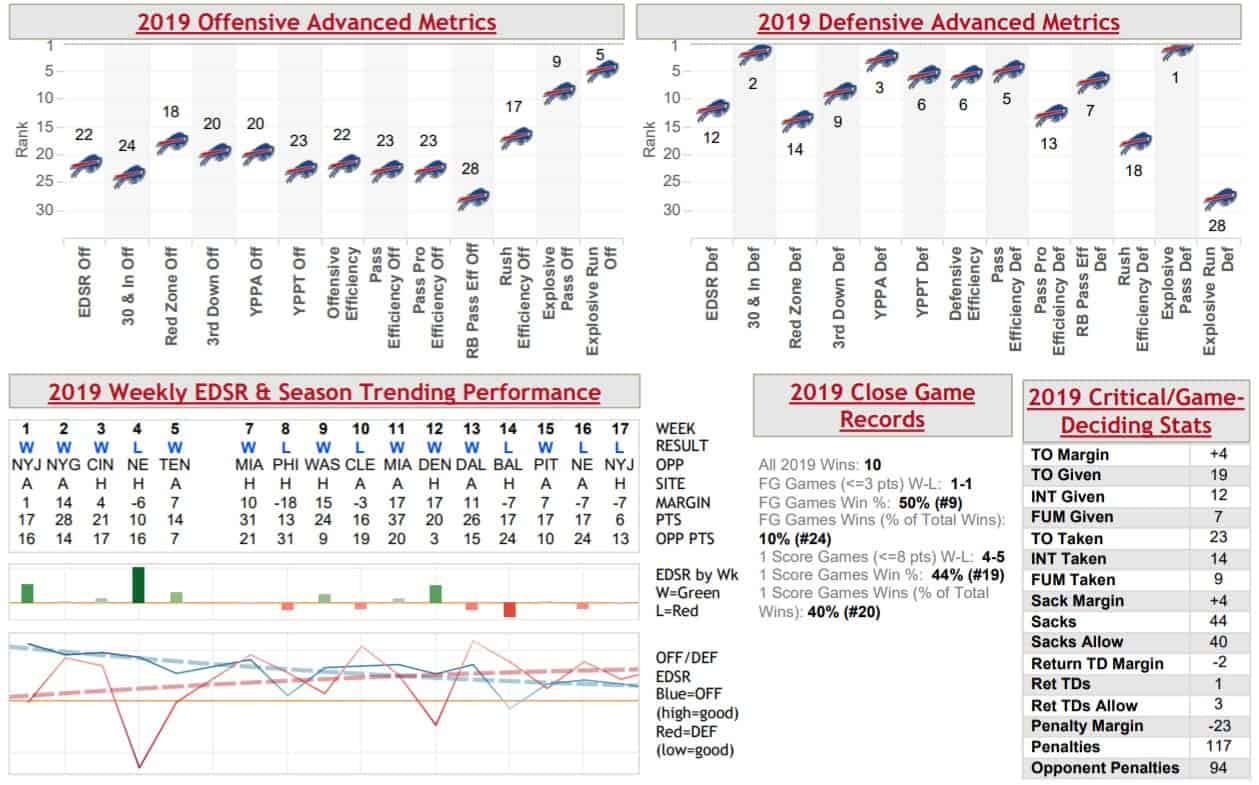
Additionally, incorporating more pre-snap motion could benefit the passing offense by giving Allen easier reads. The Bills were seven percentage points more successful when passing with pre-snap motion (fifth-highest in the NFL) but used the second-least pre-snap motion on early downs in the first three quarters of games.
While Allen might still struggle against man coverage compared to his play against zone in 2019, it would still benefit the Bills to allow him more help to identify the look before the snap. They can continue to use that and do more of what he does well, which includes more audibles based on box count and more play-action.
The Bills did what they could to help Allen in the offseason. They gave him a huge boost by trading for wide receiver Stefon Diggs, a year after they added John Brown and Cole Beasley in free agency. I mentioned last offseason how the Bills made adjustments at wide receiver personnel to add smaller, faster players capable of getting open to make targets easier for Allen, rather than going with taller, bigger but slower targets.
One piece of advice for the usage of Diggs, however, could be to put him in motion slightly more often. Diggs was only targeted after motion on two of 94 targets last year. And perhaps a result of lack of motion, Diggs received an average pre-snap cushion of only 4.6 yards, the fourth-smallest cushion of 125 receivers with 43+ targets last year.
To give Allen more assistance, the Bills built a new offensive line in 2019 and return everyone in 2020, one of just 10 teams to do so in the NFL.
Defensively, the Bills added multiple defensive linemen to go with what already was a strong group. Sean McDermott added former Panthers Mario Addison and Vernon Butler, added Quinton Jefferson, and spent their first draft pick on defensive end A.J. Epenesa.
Last year the Bills won double-digit games despite losing five games by one score. That’s a feat very difficult to accomplish. The 10-6 Bills saw five of six losses by that narrow, one-score margin. How rare?
They were the only team in 2019 to win 10+ games with 5+ losses by one-score. And in the last 30 years, it only happened 23 times in total pre-2019 Bills.
How do those teams perform the next year? That’s good news for the Bills.
Of the 23 teams, 17 won double-digit games the following season (74%) and 13 actually won more games than the prior year. Only five of 23 (22%) posted a losing record the next season. And on average, these teams won 10.2 games.
That bodes well for the Bills and their projected 9-win total. That’s the good news.
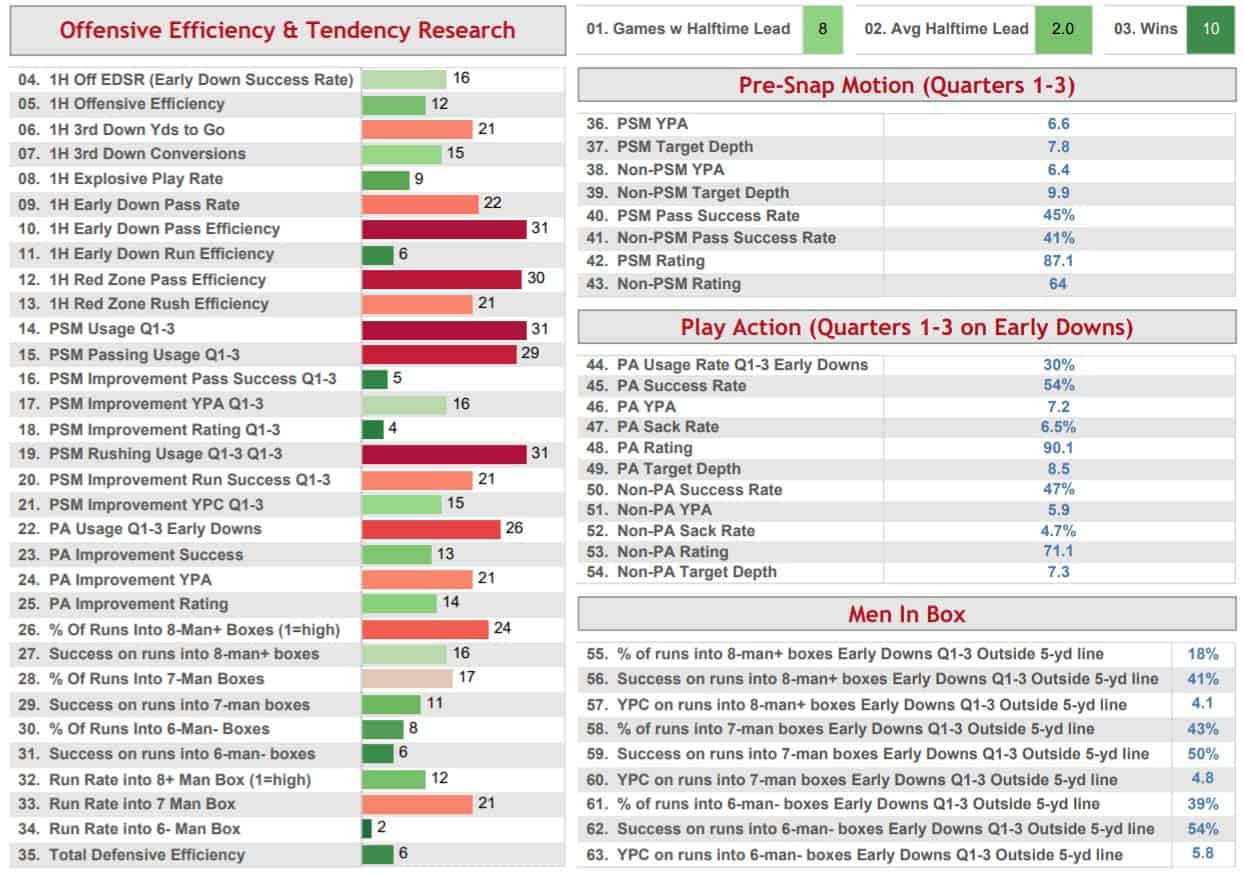
The bad news is their schedule. While Tom Brady isn’t in their division any longer, the schedule hasn’t gotten any easier for the Bills in 2020. After playing the second-easiest schedule of any team in 2019, the Bills play the 18th toughest schedule in 2020. The Bills may start fast, with the fifth-easiest schedule through Week 5. But they play the sixth-toughest schedule the rest of the season.
Where it gets toughest is for Josh Allen. The Bills played the eighth-easiest schedule of pass defenses in 2019 but play the eighth-toughest in 2020. No offense faces a tougher increase in caliber of pass defenses faced from 2019 to 2020 than the Bills.
It won’t appear as tough early in the season, as the Bills face four bottom-half pass defenses in their first five games. However, from Week 8 to Week 16, they play six of eight games against teams with top-15 pass defenses in 2019, including four games against teams that ranked top-three. Allen won’t be able to lean more on his run game than usual, as the Bills currently forecast to face the seventh-toughest schedule of run defenses.
Defensively, the Bills were phenomenal last year but that came against the NFL’s second-easiest schedule of offenses. They played nine games against bottom-10 pass offenses and went 8-1 in those games. They went 2-5 against pass offenses that ranked 20th or better. This year they face significantly tougher pass offenses.
The Bills face the fourth-toughest jump in pass offenses from 2019 to 2020.
After their Week 11 bye, the Bills are unfortunate to face two difficult schedule quirks against two tough opponents. First, they must travel to San Francisco to play on Monday night in Week 13. East coast teams playing in primetime on the west coast has been a tall order due to circadian biorhythm issues. They then have to fly across the country and play on a short week against the Steelers on Sunday night of Week 14.
Travel is more of an issue in 2020 as well. The Bills must fly to Las Vegas, Arizona, San Francisco, and Denver. And unfortunately for them, they follow up the long road trip to Las Vegas and Denver with road games the following weeks.
In 2019, the Bills never traveled west of Dallas and they haven’t had to travel further than that since 2017. The last time the team had to take multiple trips west was 2016 and they went 1-2 (beat the Rams, lost to the Seahawks and Raiders). The Bills have never before made four trips to west of Dallas in the same regular season, as they do in 2020. Since the Jim Kelly era ended, the Bills are 7-16 (30%) in those west coast games.
Buffalo Bills 2019 Passing Recap & 2020 Outlook
Josh Allen improved across the board in 2019, finishing his second season with a higher completion percentage (58.8%), yards per attempt (6.7), touchdown rate (4.3%), and a lower interception rate (2.0%) than his rookie season numbers. While a step forward was taken, all of those rate stats outside of interception rate were still significantly below league average. Buffalo ended 2019 ranked 28th in successful play rate passing (41%) and 24th in EPA via their passing offense.
The addition of Stefon Diggs provides another pass catcher to aid Allen in taking a bigger step forward in year three. Where Allen needs to improve most is downfield accuracy after completing just 35.3% of his passes over 15 yards downfield in 2019, which ranked ahead of only Kyle Allen, Mason Rudolph, and Dwayne Haskins for passers that started six or more games.
2019 Receiving Recap & 2020 Outlook
With Allen still being below league rates in efficiency, the Buffalo pass catchers fell in line. The Bills ranked 21st (50%), 27th (40%), and 30th (44%) in success rate targeting their wide receivers, running backs, and tight ends a year ago while they finished 23rd (7.4 Y/A), 18th (5.9 Y/A), and 16th (7.2 Y/A) in yards per pass attempt to each position. The Bills and Allen were driven on getting the ball to their wide receivers.
Only the Arizona Cardinals targeted their wide receivers at a higher rate than the Bills did a year ago at 66% of all pass attempts. Both John Brown and Cole Beasley arguably posted the best statistical seasons of their careers as free agent additions. Beasley (22nd) and Brown (33rd) were both in the top half of all wideouts in success rate, while the team added Stefon Diggs, who ranked 21st a year ago.
2019 Rushing Recap & 2020 Outlook
The Bills are still a run-first team, closing 2019 ninth in expected points added on the ground, 10th in the league in success rate (49%), and 13th in yards per carry (4.4 yards). As a mobile quarterback, Josh Allen was an added weapon in this area. Allen finished behind only Lamar Jackson in rushing attempts (109) among quarterbacks and third in rushing yards (510) while he was ninth of all players in the league with 50 or more carries in success rate on the ground (56%).
As a rookie runner, Devin Singletary added 775 rushing yards in 12 games. Picking up big gains, Singletary finished fourth among all running backs in explosive rushing play rate (16%). Buffalo added rookie Zack Moss in the third round this season to fill the vacated role left open from Frank Gore.

For the complete Buffalo Bills chapter, including a dozen more visuals & info-graphics, Defensive breakdown and detailed Fantasy football implication — plus the other 31 team chapters — pick up a copy of Warren Sharp’s new ‘2020 Football Preview’ book and use the coupon code “BOOK10” to take $10 off at purchase.


